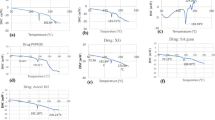Abstract
Purpose
The aim of the present work was to develop gastroretentive drug delivery system of gabapentin from different matrices prepared by hot melt or conventional wet granulation, which may enhance drug bioavailability. The influence of core type, granulation process, and coating level on the drug release rates was investigated.
Methods
Tablet cores were prepared from hydrophilic system of hypermellose, carboxy melthyl celloulse, and Avicel or hydrophobic system of ethyl cellulose, alginic acid, and stearic acid. The tablets were coated by Eudragit RL with triethyl citrate and compressed directly. These tablets were evaluated according to their in vitro dissolution profiles and release mechanisms.
Results
Hydrophobic matrices allowed the control of drug release. Hot melt granulation was an effective tool over wet granulation or coating for slowing release rates from hydrophobic tablets. Both hydrophobic polymer ratio and coating level influenced the drug release mechanism. The drug release of samples with minor proportion of ethyl cellulose and stearic acid or low Eudragit RL level was driven by anomalous transport and the increase of their proportions contributed to the erosion of the matrix.
Conclusions
Hydrophobic core tablet prepared from hot melt granulation and coated by Eudragit RL has shown to be a promising formulation intended to gastroretentive gabapentin delivery system.





Similar content being viewed by others
References
Deshpande AA, Rhodes CT, Shah NH, Malick AW. Controlled-release drug delivery systems for prolonged gastric residence: an overview. Drug Dev Ind Pharm. 1996;22(6):531–9.
Singh BN, Kim KH. Floating drug delivery systems: an approach to oral controlled drug delivery via gastric retention. J Control Release. 2000;63(3):235–59.
Chavanpatil MD, Jain P, Chaudhari S, Shear R, Vavia PR. Novel sustained release, swellable and bioadhesive gastroretentive drug delivery system for ofloxacin. Int J Pharm. 2006;316(1–2):86–92.
Stewart BH, Kugler AR, Thompson PR, Bockbrader HN. A saturable transport mechanism in the intestinal absorption of gabapentin is the underlying cause of the lack of proportionality between increasing dose and drug levels in plasma. Pharm Res. 1993;10(2):276–81.
Gidal BE, Maly MM, Budde J, Lensmeyer GL, Pitterle ME, Jones JC. Effect of a high-protein meal on gabapentin pharmacokinetics. Epilepsy Res. 1996;23(1):71–6.
McLean MJ. Clinical pharmacokinetics of gabapentin. Neurology. 1994;44((6):suppl 5):S17–22.
Goldenberg MM. Overview of drugs used for epilepsy and seizures: etiology, diagnosis, and treatment. P T. 2010;35(7):392–415.
Backonja M, Glanzman RL. Gabapentin dosing for neuropathic pain: evidence from randomized, placebo-controlled clinical trials. Clin Ther. 2003;25(1):81–104.
Cundy KC, Sastry S, Luo W, Zou J, Moors TL, Canafax DM. Clinical pharmacokinetics of XP13512, a novel transported prodrug of gabapentin. J Clin Pharmacol. 2008;48(12):1378–88.
Chen C, Cowles VE, Sweeney M. The intestinal absorption mechanism of gabapentin makes it appropriate for gastroretentive delivery. Curr Clin Pharmacol. 2013;8(1):67–72.
Chordiya M, Gangurde H, Borkar V. Technologies, optimization and analytical parameters in gastroretentive drug delivery systems. Curr Sci. 2017;112(5):946–53.
Rowe RC, Sheskey PJ, Quinn, ME. Handbook of pharmaceutical excipients. 6th ed. London: Pharmaceutical Press; 2009.
Carbinatto FM, de Castro AD, Evangelista RC, Cury BSF. Insights into the swelling process and drug release mechanisms from cross-linked pectin/high amylose starch matrices. AJPS. 2014;9:27–34.
Costa P, Lobo JMS. Modeling and comparison of dissolution profiles. Eur J Pharm Sci. 2001;13:123–33.
Lara-Hernández B, Hernández-León A, Villafuerte-Robles L. Effect of stearic acid on the properties of metronidazole/methocel K4M floating matrices. Braz. J Pharm Sci. 2009;45(3):497–505.
Author information
Authors and Affiliations
Corresponding author
Rights and permissions
About this article
Cite this article
Alkhalidi, B.A., Albarahmieh, E., Qassim, S.M. et al. An Investigation into Formulation and Processing Strategies to Drive Gastroretention of Gabapentin Tablets. J Pharm Innov 12, 367–373 (2017). https://doi.org/10.1007/s12247-017-9300-2
Published:
Issue Date:
DOI: https://doi.org/10.1007/s12247-017-9300-2




